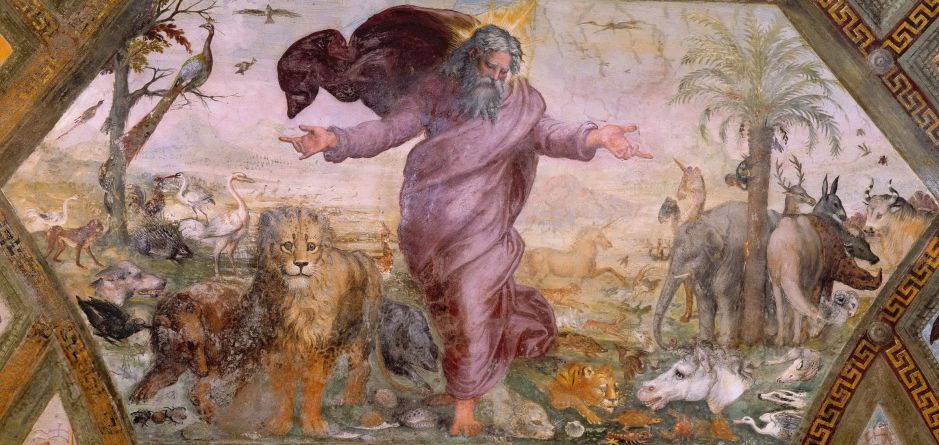In classical Greek times, unicorns didn’t feature in myth or legend, but in the natural histories written by Strabo and others. Artists well into the Renaissance were also convinced of the existence of the species, painting them alongside real animals in non-mythological works. They have their roots in ancient Indo-European civilisations, and have permeated through many subsequent cultures. Although they do vary, by the Middle Ages most had settled on a horse-like creature with a single and straight long horn on their forehead.
One of the first early modern artists to feature unicorns in several of his paintings was Hieronymus Bosch. These are best known in his Garden of Earthly Delights, but appear in at least another two of his works.

In the left panel of The Garden of Earthly Delights (c 1495-1505) is a curious mixture of real and imaginary creatures. There’s an elephant and a giraffe, both early depictions of the species, together with monkeys, brown bears, rabbits, and more. But there too is a carefully painted white unicorn drinking at the lake on the left.

This scene of The Creation of the Animals from the first bay of Raphael’s Loggia in the Palazzo Apostolico of the Vatican is the last of four showing the Creation. God the Creator walks among a marvellous collection of animals and birds. Notable among these are a unicorn, below God’s left hand, and an early image of a rhinoceros at the right. To Raphael the unicorn was as real as a rhinoceros.

In Tintoretto’s Creation of the Animals, the first of his Old Testament cycle for the Scuola della Trinità in Venice, God flies along as he creates pairs of different species of bird, fish, and animal, from cormorants to rabbits. At the upper right corner is the unmistakable head of a white unicorn, showing that Tintoretto also believed that they were real rather than merely legendary.

Maerten de Vos may have based this portrait of a Unicorn (1572) on travellers’ tales from those who had returned from Africa, judging by the appearance of the locals in the background.

Paulus Potter’s Orpheus and Animals from 1650 shows a wide range of different animal species, some of which were still not well-known at the time. These include a Bactrian camel (two humps), donkey, cattle, ox, wild pig, sheep, dog, goat, rabbit, lions, dromedary (one hump), horse, elephant, snake, deer, lizard, wolf, monkey and unicorn.
Unicorns also acquired a symbolic meaning, given their uniform colour of white: they were associated with chastity.

Once thought to have been painted by Raphael, this portrait of a Young Woman with Unicorn from about 1506 is now believed to have been painted by Ridolfo Ghirlandaio (1483-1561). It has been claimed to show Giulia Farnese (1474-1524), the sister of Pope Paul III, who became Pope Alexander VI’s mistress. Until it was cleaned and overpainting removed, the unicorn remained undiscovered, and it was thought to be a portrait of Saint Catherine. The inclusion of a unicorn as a symbol of chastity may in this case have been a mark of irony on the part of the artist, or wishful thinking on the part of the sitter, given that her papal lover had died a few years before this is thought to have been painted.

More typical is Moretto da Brescia’s painting of Saint Justina with the Unicorn, Venerated by a Patron from about 1530-34. This saint, the patron of the city of Padua in Italy, took a vow of lifelong chastity, so the unicorn has become one of her attributes.

Domenichino’s fresco of a Virgin and Unicorn from about 1602, which he painted in the Palazzo Farnese in Ponte, Italy, shows the standard legend of a virgin taming a wild white unicorn. This too is alleged to show Giulia Farnese, mistress of Pope Alexander VI, although she had died about eighty years earlier. He painted this when working under the direction of Annibale Carracci, who died a few years later.
By the late seventeenth century, the unicorn had been thoroughly debunked and all but vanished from paintings until its return with Symbolism.

In the mid 1880s, Gustave Moreau revived the unicorn as a symbol of chastity when retelling its legendary existence. The Unicorn (1884-85) reveals those rich symbolic associations as Moreau repeatedly painted a single unicorn being fondled by an almost nude woman, alluding to the expansive complex of mediaeval myths associating the animal with a virgin or the Virgin, who seem to be the only humans capable of trapping a unicorn.

The unicorn continues to appear in more modern paintings of fantasy worlds, such as that of the American artist Arthur Bowen Davies. This is probably his most famous painting, Unicorns (Legend—Sea Calm), completed in 1906. It appears strongly influenced by the European Symbolist movement of the late nineteenth century.

